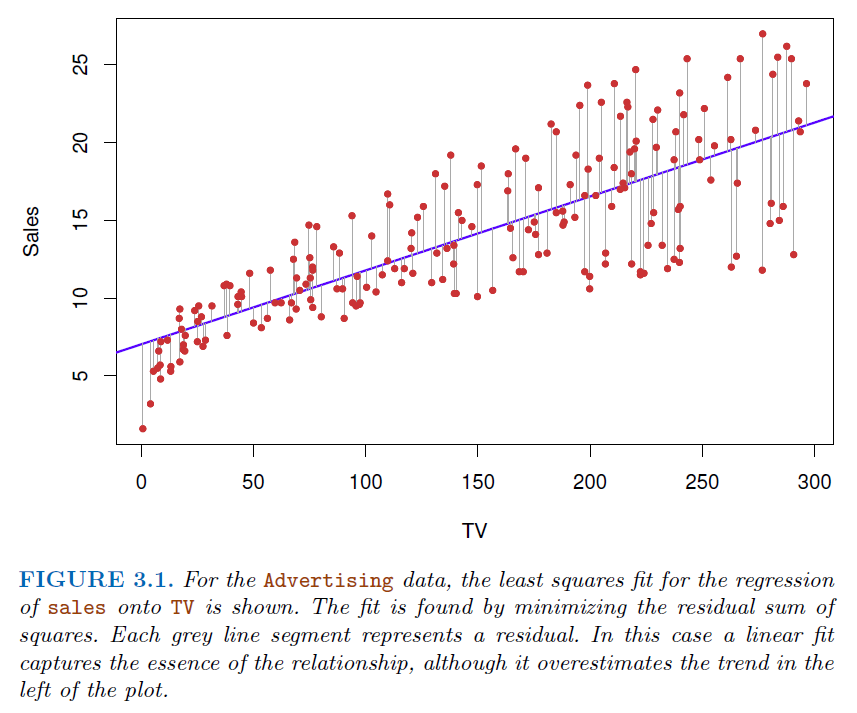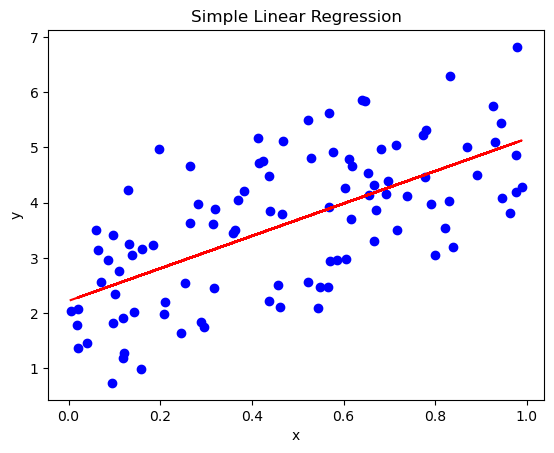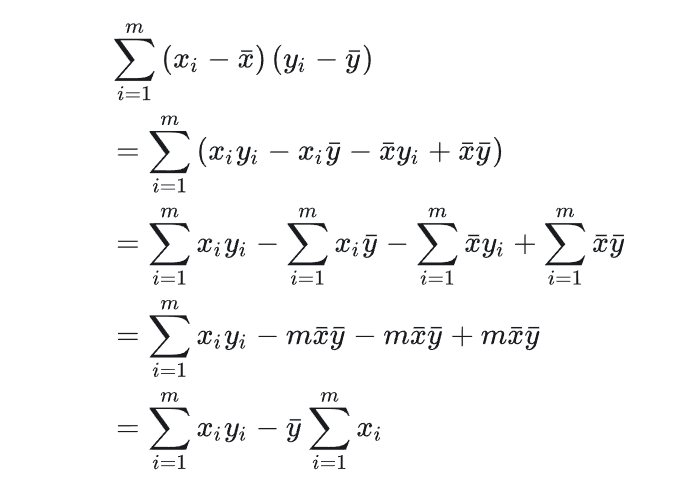2. Regression#
2.1. Simple Linear Regression#

# Import necessary libraries
import numpy as np
from sklearn.linear_model import LinearRegression
import matplotlib.pyplot as plt
# Generate some random data for demonstration
np.random.seed(0) # Seed for reproducibility
x = np.random.rand(100, 1) # 100 random numbers for independent variable
y = 2 + 3 * x + np.random.randn(100, 1) # Dependent variable with some noise
# Create a linear regression model
model = LinearRegression()
# Fit the model with our data (x - independent, y - dependent)
model.fit(x, y)
# Print the coefficients
print("Intercept (beta_0):", model.intercept_)
print("Slope (beta_1):", model.coef_)
Intercept (beta_0): [2.22215108]
Slope (beta_1): [[2.93693502]]
# Use the model to make predictions
y_pred = model.predict(x)
# Plotting
plt.scatter(x, y, color='blue') # actual data points
plt.plot(x, y_pred, color='red') # our model's predictions
plt.title('Simple Linear Regression')
plt.xlabel('x')
plt.ylabel('y')
plt.show()

2.1.1. Find Best estimator of
2.1.1.1. Ordinary Least Squares#
The goal is to find the values of
Steps to calculate it
Calculate the partial derivatives of intercept
Calculate the partial derivative of slope
Replace
According to the Summation Property (As shown below):

We will have
2.1.2. Assessing the Accuracy of Coefficient Estimates#
Where
These two standard errors can be used to compute
confidence interval, for example, for 95% confidence interval, it has the form [
2.1.3. Hypothesis Testing#
Standard errors can be used to perform
hypothesis testson coefficients.To test the null hypothesis, we compute a
t-statistic, given by
This value follows a t-distribution with
n-2degrees of freedomSince

2.1.4. Assessing the Overall Accuracy of the Model#
We compute the
Residual Standard ErrorWhere RSS is the
residual sum-of-squares
We can also use
R-squared(fraction of variance explained):Where
total sum of squaresAlso, In the simple linear regression setting,

# Example data
x = np.array([1., 2., 3., 4., 5.]).reshape(-1, 1)
y = np.array([2., 4., 5., 8., 7.])
# Calculating means
x_mean = np.mean(x)
y_mean = np.mean(y)
# Calculating Beta_1
numerator = sum([i*j for i,j in zip(x-x_mean,y-y_mean)])
denominator = np.sum((x - x_mean)**2)
beta_1 = numerator / denominator
print("Beta_1 (slope) using OLS:", beta_1)
Beta_1 (slope) using OLS: [1.4]
2.1.5. Maximum likelihood estimation#
In the context of linear regression, MLE assumes that the residuals (differences between observed and predicted values) are normally distributed.
The method finds the parameter values that maximize the likelihood of observing the given data.
2.2. Multiple Linear Regression#
Correlations amongst predictors cause problems (
multicollinearity):The
variance of all coefficienttends to increase, sometimes dramatically.p-valueAlso, it’s hard to interpret.
Claims of causalityshould be avoided!


2.2.1. Important Question (Hypothesis testing)#
Is at least one of the predictors
For this question, we use the
Where

If
Do all the predictors help to explain
Forward Selection
Begin with the
null modelFit
psimple linear regression and add the null model the variable results in the lowestRSSAdd to that model the variable that results in the lowest
RSSamongst all two-variable models.Continue until stopping rules is satisfied (e.g.
p-value >0.05for all remaining variables)
Backward Selection

Model Selection
Besides
RSS, there are some other criteria for choosing an “optimal” member in stepwise searching, includingAkaike information criterion (AIC),Bayesian information criterion (BIC),adjusted R-squared
How well does the model fit the data?
Given a set of predictor values, what response value should we predict, and how accurate is our prediction?
2.2.2. Polynomial regression (non-linear effects)#


2.3. Interesting Quotes by famous Statisticians#
Essentially, all models are wrong, but some are useful
George Box
The only way to find out what will happen when a complex system is disturbed is to disturb the system, not merely to observe it passively
Fred Mosteller and John Tukey, paraphrasing George Box


